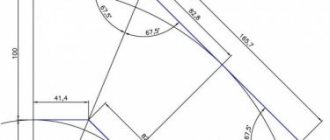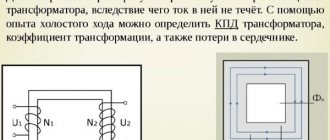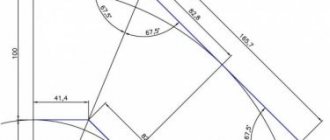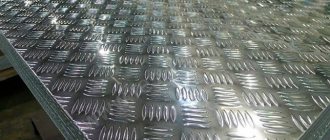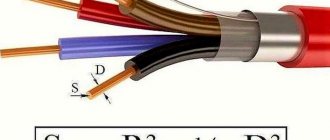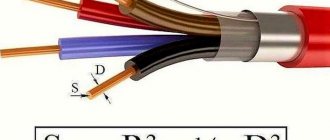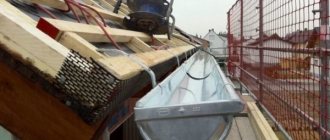Galvanized steel sheet is a metal product used as a semi-finished product for the manufacture of products using cold forming, stamping and subsequent painting. Thin (usually up to 2 mm thick) hot- and cold-rolled sheets of carbon steel of ordinary quality and high-quality, of various degrees of deoxidation, are used as the starting material.
How much does 1 m2 of 0.7 mm galvanized steel weigh?
At the moment, there are two ways to determine weight.
- Using a table;
- Using formula.
Everything is clear with the table. Next, for your convenience, tabular information will be displayed, which will indicate the exact weight in kilograms. All you need is to keep it in a convenient place and use it when necessary.
Table for calculating the weight of galvanized steel sheets in 1 kg. and 1t:
| Thickness of galvanized steel, mm | Quantity of m 2 in 1 ton of galvanized steel | Weight of 1 m 2 galvanized steel, kg |
| 0,40 | 299,40 | 3,34 |
| 0,45 | 267,92 | 3,73 |
| 0,50 | 242,42 | 4,13 |
| 0,55 | 221,36 | 4,52 |
| 0,60 | 203,67 | 4,91 |
| 0,65 | 188,60 | 5,31 |
| 0,70 | 175,59 | 5,70 |
| 0,75 | 164,2 | 6,09 |
| 0,80 | 154,32 | 6,48 |
| 0,90 | 137,65 | 7,27 |
| 1,00 | 124,22 | 8,05 |
| 1,10 | 114,09 | 8,83 |
| 1,20 | 103,95 | 9,62 |
| 1,50 | 83,51 | 11,97 |
| 2,00 | 62,89 | 15,90 |
| 2,50 | 50,45 | 19,82 |
Calculation table for galvanized steel with polymer coating 1 m2:
| Thickness of galvanized steel with coating, mm | Quantity of m 2 in 1 ton of galvanized steel with coating | Weight of 1 m 2 galvanized steel with coating, kg |
| 0,4 | 318,47 | 3,14 |
| 0,45 | 283,29 | 3,53 |
| 0,5 | 253,81 | 3,94 |
| 0,55 | 232,02 | 4,31 |
| 0,6 | 213,22 | 4,69 |
| 0,65 | 196,67 | 5,08 |
| 0,7 | 182,15 | 5,49 |
| 0,75 | 170,07 | 5,88 |
| 0,8 | 158,98 | 6,29 |
| 0,9 | 141,04 | 7,09 |
| 1 | 125,94 | 7,94 |
The second method - calculation using a formula is a little more complicated. The formula looks like this:
- M – calculated weight of zinc-coated steel sheet, in kg;
- M1 – indicator of steel mass in kg;
- M2 is an indicator of the mass of zinc in kg.
Assortment according to GOST.
In galvanized sheets manufactured according to GOST 14918 80, the weight varies between 3.34-19.82 kg/m². The technical feature of the manufacture of the product is important for the rigidity and possibility of producing rolled or sheet assortments: the smaller the difference between the initial thickness of the steel before rolling and the final one, the more suitable it is for further stamping and deformation.
How to calculate the weight of galvanized steel sheets?
M=M1+M2, where M is the final weight of the sheet (kg), M1 is the weight of iron (kg), M2 is the weight of zinc (kg).
In this case, M1=T1 x l1 x H1 x P1,
where T1 is the thickness of the iron sheet (mm). When calculating, it is important to take into account that the thickness of the iron is 0.05 mm lower than the finished product for class 1 zinc special coating and 0.03 mm less for class 2; l1 - length of sheet iron (m); H1 - width of iron sheet (m); P1 is an indicator of iron density (7.85 t/m3).
M2=T2 x l2 x H2 x P2,
where, T2 is the thickness of the galvanized layer (depending on the category, where the thickness of the 1st category is 0.0381 mm, and the second is 0.0216 mm); l2 - length of special coating (m); H2 - width of special coating (m); P2 is an indicator of zinc density (7.13 t/m3).
Thanks to the formula, it is possible to make calculations before purchasing. This will allow you not to be deceived and to accurately calculate the required amount of material.
There are also tables that already have calculations and ready-made results. Therefore, in some cases, avoiding calculations, you can refer to the following tables:
Table for calculating the mass of galvanized sheet steel
| Thickness of galvanized steel | Number of m2 of galvanized steel in 1 ton | Weight 1m2 galvanized steel |
| 0.4mm | 299.40m2 | 3.34kg |
| 0.45mm | 267.92m2 | 3.73kg |
| 0.5mm | 242.42m2 | 4.13kg |
| 0.55mm | 221.36m2 | 4.52kg |
| 0.6mm | 203.67m2 | 4.91kg |
| 0.65mm | 188.60m2 | 5.31kg |
| 0.7mm | 175.59m2 | 5.70kg |
| 0.75mm | 164.2m2 | 6.09kg |
| 0.8mm | 154.32m2 | 6.48kg |
| 0.9mm | 137.65m2 | 7.27kg |
| 1mm | 124.22m2 | 8.05kg |
| 1.1mm | 114.09 m2 | 8.83kg |
| 1.2mm | 103.95m2 | 9.62kg |
| 1.5mm | 83.51m2 | 11.97kg |
| 2mm | 62.89m2 | 15.9kg |
| 2.5mm | 50.45m2 | 19.82kg |
Table for calculating the mass of galvanized steel with polymer coating
| Thickness of galvanized steel with special coating | Number of m2 of galvanized steel with special coating in 1 t | Weight 1m2 of galvanized steel with special coating |
| 0.4mm | 318.47m2 | 3.14kg |
| 0.45mm | 283.29m2 | 3.53kg |
| 0.5mm | 253.81m2 | 3.94kg |
| 0.55mm | 232.02m2 | 4.31kg |
| 0.6mm | 213.22m2 | 4.69kg |
| 0.65mm | 196.67m2 | 5.08kg |
| 0.7mm | 182.15m2 | 5.49kg |
| 0.75mm | 170.07m2 | 5.88kg |
| 0.8mm | 158.98m2 | 6.29kg |
| 0.9mm | 141.04m2 | 7.09kg |
| 1mm | 125.94m2 | 7.94kg |
Calculation of electric current by power: formulas, online calculation, selection of machine
Calculation of boards and timber in one cubic meter - formulas, calculation examples, tables
Galvanized sheet
Corrosion destroys about 10% of all metal produced in the world; every sixth or seventh blast furnace works in vain: the steel smelted in it completely turns into rust within a year. Even in developed countries with high technology, the damage caused by corrosion can reach 4% of GDP. One of the most effective ways to protect against corrosion is to apply a protective layer of zinc to the surface of metal structures. Galvanizing is several times cheaper than paint and varnish coatings, and, at the same time, extends the service life of the metal by 30-40 years.
Sheet (also rolled) galvanized steel is produced:
- hot galvanizing of thin-sheet cold-rolled steel coils;
- by applying galvanic coating;
- spraying (gas-thermal method);
- thermal diffusion galvanizing.
The most common is hot-dip galvanizing; this technology makes it possible to produce a strong and durable anti-corrosion coating with a thickness of 10 to 60 microns at the lowest cost. Matte white, sometimes with a gray tint without shine, the coating obtained by hot-dip galvanizing is inferior in decorative qualities to shiny and silver galvanized ones, but has greater hardness and excellent strength characteristics.
Why do you need to know the mass of a leaf?
The following points need to be highlighted here:
- To determine the dimensions of the profile of supports and floors. Based on the weight of the sheets, the load on the load-bearing elements of the metal structure is determined. Neglect of this point leads to premature destruction of the structure;
- The weight of the sheet steel gives an idea of the thickness of the galvanized surface. If the sheet weight exceeds its nominal value, while the total thickness corresponds to the declared value, this indicates that the sheet is galvanized of poor quality. The amount of zinc on the metal surface is underestimated, which will negatively affect its service life.
Methods for determining the weight of galvanization
There are 2 methods for determining the mass of galvanized sheet steel:
- Calculation from tabular data;
- Calculation using formulas.
The tables are more or less clear. They give a reference value for the mass of 1 sq.m. galvanized steel depending on its thickness. You can find them in technical literature.
As an example, let’s calculate the weight of galvanized sheeting of 0.5 mm with an area of 2 square meters. meters.
According to the Aviation Scales Handbook:
- Galvanized sheet 0.5 mm - 4.13 kg/m2
- Galvanized sheet 0.7 mm - 5.70 kg/m2
- Galvanized sheet 1.0 mm - 8.05 kg/m2
Multiplying the value we need by the size of our area, we find that the sheets weigh 8.26 kg.
Galvanized sheet GOST 14918-80 (technical conditions and requirements)
Standard 14918-80 applies to cold-rolled carbon steel 0.5 to 2.5 mm thick that has been continuously hot-dip galvanized (which results in the formation of a corrosion-resistant Zn-Fe alloy on the metal surface). For galvanizing low-carbon steels, technical conditions are determined separately, by standard R 52246-2004.
| № | Classification of galvanized steel GOST 14918-80 | Groups, categories, classes | Abbreviation (used for symbolic designation) |
| 1 | Assignment Groups | General purpose | HE |
| For cold stamping | XSh | ||
| For cold profiling | HP | ||
| For painting | PC | ||
| 2 | Hood categories | Very deep draw | VG |
| Deep | G | ||
| Normal | N | ||
| 3 | Tread quality | Reduced thickness variation | UR |
| Normal thickness variation | HP | ||
| 4 | Galvanization layer thickness, class | I class | 1 |
| II class | 2 | ||
| Elevated | P | ||
| 5 | Appearance of galvanization/type of crystallization pattern (by agreement with the customer) | With crystallization pattern | KR |
| Without crystallization pattern | MT |
Galvanized sheet, dimensions according to GOST 19904-90 (assortment)
Dimensions, maximum deviations and requirements for manufacturing accuracy for galvanized steel are established by the GOCT 19904-90 assortment in the same way as for non-galvanized cold-rolled sheet steel.
Galvanized steel according to specifications in accordance with GOCT 14918-80 is manufactured in widths from 700 to 1800 mm (size increments depending on the range of 50, 100 and 150 mm), lengths from 1000 to 6000 mm (size increments 20, 80, 100, 150, 200, 300, 500 mm), however, by agreement with the consumer, if necessary, other sizes can be installed.
The thickness of the galvanized sheet is regulated in the range from 0.5 to 2.55 mm, and the assortment determines the following dimensional step:
- thickness range 0.5-0.8 mm - step is 0.05 mm;
- range 0.8-1.8 mm - step 0.1 mm;
- range 1.8-2.5 - step 0.2, last - 0.3 mm.
Weight of galvanized sheet
The weight of a galvanized sheet (one square meter) can theoretically be calculated using the formula:
- M - weight of 1 m² of galvanized sheet, kg;
- M1 - weight of 1 m² of steel sheet without a cladding layer 1 mm thick;
- t1 is the thickness of the steel sheet without coating;
- M2 - weight of 1 m² of zinc cladding layer 1 mm thick;
- t2 is the thickness of the zinc layer on both sides of the sheet.
The specific gravity of carbon steel is 7.85 g/cm³, or, for convenience of calculations, it is generally accepted that 1 m² of sheet steel with a thickness of 1 mm weighs 7.85 kg. The specific gravity of zinc is slightly less - 7.13 g/cm³, that is, 1 m² of zinc with a thickness of 1 mm weighs 7.13 kg. Taking into account these quantities, formula (1) can be rewritten:
The thickness of the zinc layer depends on the coating class (GOCT 14918-80) and is indicated in the symbol:
| Class | Limit values for layer thickness, mm | Weight of tread layer on both sides, kg |
| I | From 0.018 to 0.04 Average value 0.029 | 0.258-0.570 Average 0.414 |
| II | From 0.01 to 0.018 Average value 0.014 | 0.1425-0.258 Average 0.200 |
| P (increased) | From 0.04 to 0.06 | 0.57-0.855 Average 0.712 |
To calculate the weight of a galvanized sheet, you can also use a formula that takes into account the weight of the coating depending on the class of layer thickness:
- M - galvanized sheet weight 1 m², kg
- t1 is the thickness of the steel sheet without coating;
- Mp.s. - the average weight of the tread layer depending on the thickness class, the value is standardized by GOCT 14918-80.
To calculate how much a galvanized sheet weighs (the weight of one sheet of the required size), use the formula:
- Msheet - weight of one galvanized sheet, kg;
- M – weight of 1 m², kg;
- S—sheet area, m².
Calculation of the mass of corrugated sheets
The weight of 1 m2 of profiled galvanized sheet depends on the thickness of the rolled product and the geometry of the profile. The table shows the weights of the most popular brands of corrugated sheets.
| Brand of corrugated sheet | Thickness, mm | Weight 1 m2, kg | Brand of corrugated sheet | Thickness, mm | Weight 1 m2, kg |
| For roofing and load-bearing | Universal | ||||
| N 57 | 0,55 | 7,4 | NS 35 | 0,55 | 6,3 |
| 0,7 | 8,6 | 0,7 | 7,4 | ||
| 0,8 | 9,8 | 0,8 | 8,4 | ||
| N 60 | 0,7 | 8,8 | NS 44 | 0,7 | 8,3 |
| 0,8 | 9,9 | 0,8 | 9,4 | ||
| 0,9 | 11,1 | Wall | |||
| N 75 | 0,7 | 9,8 | From 15 | 0,55 | 5,4 |
| 0,8 | 11,2 | 0,7 | 6,8 | ||
| 0,9 | 12,5 | From 18 | 0,55 | 6,3 | |
| N 114 | 0,8 | 13,0 | 0,7 | 7,4 | |
| 0,9 | 15,6 | From 21 | 0,55 | 6,3 | |
| 1,0 | 17,2 | 0,7 | 7,4 | ||
To determine the mass of a sheet, the weight of 1 m2 is multiplied by its length and width.
Rules for calculating weight
You can calculate the mass of one sheet using an ordinary calculator if you know certain rules. In particular, the weight is calculated by area. This method is suitable for metal of any thickness.
In order to determine this indicator, it is necessary to multiply the length, thickness and width of the material, and all indicators must be converted into meters. The resulting number is further multiplied by 7.65 kg/dm3 - this number indicates the density of the steel sheet.
As a result, a certain number will be obtained, which will indicate the mass in kilograms. It is multiplied by the number of sheets in the bundle, after which the information obtained is compared with the carrying capacity of the vehicle.
It should be noted that the mass of galvanized steel will practically not differ from ferrous metal, because the thickness of the zinc coating is minimal and is within a few micrometers.
Many virtual resources have at their disposal an application such as a metal calculator, with which you can calculate the mass of different grades of steel, including galvanized.
Dimensions
According to the current state standard 14918-80, the width of the sheets can be from 75 to 180 cm. Another state standard 19904-90 says that galvanized rolled steel can have dimensions from 850 to 3500 mm in length and from 750 to 5000 mm in width.
However, using sheets that are too large or too small is usually not very convenient. The most popular are 1000x2000 mm or 1250x2500 mm and up to 1 mm thick.
Such products do not weigh too much, and also do not take up much space, which makes their transportation very convenient, even on the roof of a car, which can easily carry up to 30 galvanized sheets of medium thickness.
The range of materials in terms of their main indicators is quite large, so before choosing, you should decide what size sheet will be most suitable for carrying out certain work.
You should be especially careful when creating a roofing covering, since a large number of factors must be taken into account:
- Roof dimensions;
- Possibility of delivery of sheets of certain sizes;
- Technological methods for lifting to the roof;
- Unloading methods and many other nuances.
As a rule, when building private houses or country cottages, standard sheets are used , the dimensions of which are 1 by 2 meters with a thickness of 0.55 mm. Instead, sometimes they take material 1250 mm by 2500 mm.
